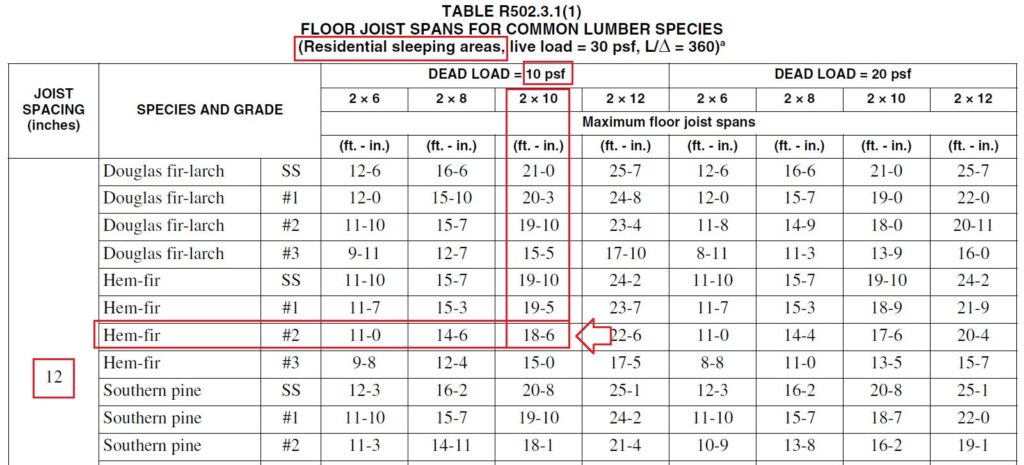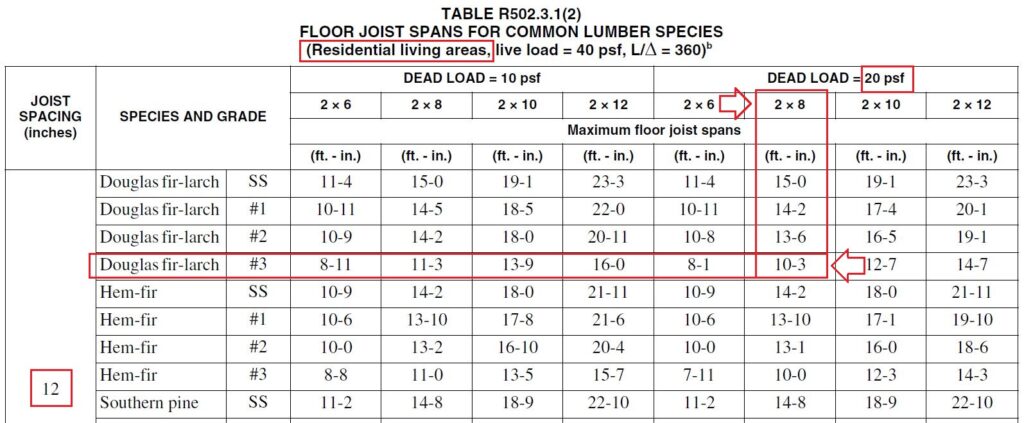Related Articles to Read:
- How to Size Roof Rafters Per the IRC | Easily Explained with Examples
- How to Size Ceiling Joists Per the IRC | Easily Explained with Examples
Want to learn how to easily size floor joists?
Chapter 5 of the 2018 International Residential Code (IRC) regulates the design and construction of floor systems. Floor members must be properly designed to ensure they provide adequate support as required by the loads that are imposed on them.
The floor systems covered in this chapter consist of 4 different types of floor systems.
- Wood Floor Framing
- Wood Floors on the Ground
- Steel Floor Framing
- Concrete Slabs on the Ground
In this post we will cover wood floor framing members. The design and construction of wood floor joists are found in Section R502 of the International Residential Code (IRC).
Section R502 outlines the wood floor framing criteria which also includes prescriptive span tables.
In this post we will learn how to correctly size a floor joist based on its span, spacing and species of wood used.
Fun Tip: To learn the difference between the International Residential Code (IRC) verses the International Building Code (IBC), be sure to check out this POST.
Floor Joist Loads
Wood floor joists are sized based on one of two tables found in the code. These span tables list allowable floor joist spans for common lumber sizes based on what design load scenario is applied. Before we look at these tables, we need to make sure the correct design loads are determined prior to selecting the correct table.
The code recognizes 2 types of loads that are applied to floor joists: Live Loads and Dead Loads.
Live loads are defined by the code as follows:
Loads produced by the use and occupancy of the building or other structure. This does not include construction or environmental loads.
Dead loads are defined by the code as follows:
The weight of the materials of construction incorporated into the building, including but not limited to walls, floors, roofs, ceilings, stairways, built-in partitions, finishes, cladding, and other similarly incorporated architectural and structural items, and fixed service equipment.
It is important to note that floor systems can also serve as a diaphragm to resist lateral loads from earthquakes and wind, however chapter 5 does not base the floor system requirements on these loads. Chapter 6 accounts for these loads but in this post we will just cover the gravity loads mentioned above as based on chapter 5 of the code.
Floor Joist Span Tables
As mentioned above, the span tables within the code list the allowable floor joist spans for common lumber sizes based on what design load scenario is applied.
Now in order to select the correct table, we must understand which Live Load is to be use since the 2 tables vary based on the type of live load used.
For Residential Sleeping Areas we must use Table R502.3.1(1) and for Residential Living Areas we must use Table R502.3.1(2).
The code requires floor joists installed in residential sleeping areas to be designed with a live load of 30 pound per square foot (psf), which is what Table R502.3.1(1) is prescriptively designed for, while at the same time the code required floor joists installed in residential living areas to be designed with a live load of 40 pounds per square foot (psf), which is what Table R502.3.1(2) is prescriptively designed for.
Therefore if your installing floor joists serving a sleeping room, you must use Table R502.3.1(1) and for all other areas of a building other than a sleeping room, you must use Table R502.3.1(2).
It is important to note however that Table R502.3.1(1) can NOT be used for live loads that exceed 30 psf and dead loads that exceed 20 psf. As well as Table R502.3.1(2) can NOT be used for live loads that exceed 40 psf and dead loads that exceed 20 psf.
If these loads are exceeded, the design is outside the prescriptive standards of the table and at that point the floor joists must be design in accordance with accepted engineering practice.
Now with all that out of the way, lets take a look at those tables to learn how to correctly size floor joists using the prescriptive standards:


For simplicity, only the table headers are shown above. The table header must be understood first before we can correctly size the floor joist. Each table is labeled. As you can see the first table is designed for residential sleeping areas while the second table is designed for residential living areas.
The tables provide the following information on them:
- Floor Joist Spacing in inches (12, 16, 19.2, 24)
- Species and Grade of Lumber
- Various Lumber Size Options (2×6, 2×8, 2×10, 2×12)
- The maximum floor joist span based on the lumber size, species/grade, and spacing used.
Now, in order to correctly size floor joists, lets take a look at a few examples.
How to Size Floor Joists
Sizing Floor Joists – Floor Joist Size Example 1
Question: What is the maximum allowable span of a 2×10 Hem-fir #2 floor joist spaced 12 inches on center supporting a sleeping room with a dead load of 10 psf?
First step, lets collect all the given information within the question:
- Sleeping Room: Use Table R502.3.1(1)
- Floor Joist Spacing: 12 inches
- Species and Grade: Hem-fir #2
- Lumber Size used: 2×10
Now lets find the maximum allowable span for a 2×10 member given the above scenario:

Therefore given the above example, the maximum allowable span for a 2×10 member is 18′-6″.
Sizing Floor Joists – Floor Joist Size Example 2
Now lets try another example, but this time a span will be given and you must select the correct size lumber to be used given the following scenario:
Question: Where Douglas fir-larch #3 floor joists are to be spaced 12 inches on center supporting a living room with a dead load of 20 psf, what is the minimum allowable joist size when required to span 10′-0″ in length?
First step, lets collect all the given information within the question:
- Living Room: Use Table R502.3.1(2)
- Floor Joist Spacing: 12 inches
- Species and Grade: Douglas fir-larch #3
- Floor Joist Span: 10′-0″
Now lets find the minimum allowable joist size given the above scenario:

Therefore given the above example, the minimum allowable joist size for douglas fir-larch #3 lumber spanning 10′-0″ is a 2×8 since it can span 10′-3″. A 2×6 member for example cannot be used since it can only span 8-1″.
To Learn more about the design and construction of wood floor framing, be sure to check out Section R502 of the 2018 International Residential Code (IRC).
Hopefully given the above examples you can find it easier to size wood floor joists per the Tables within the International Residential Code.
In conclusion, lets take a quick second to answer some common frequently asked questions related to floor joists.
What is the standard size of a floor joist?
The standard size of a floor joist can really be any size as long as it is not smaller than the minimum size as required per the code. The minimum size of a floor joist is determined using the prescriptive tables found within Chapter 5 of the International Residential Code (IRC).
How far apart should floor joists be?
The spacing of floor joists is just one of the components used to determine the minimum size of the floor joist. Per the prescriptive tables found in Chapter 5 of the International Residential Code (IRC), the standard floor joist spacing used is 12, 16, 19.2, and 24 inches on center.
How far can a floor joist span?
The maximum span of a floor joist is based on the size, spacing and species of wood used along with the design loads applied to the floor joist. The prescriptive tables found in Chapter 5 of the International Residential Code (IRC) can be used to determine the maximum span of a floor joist.
.
* Reference Source – 2018 International Residential Code – [Buy on Amazon]
